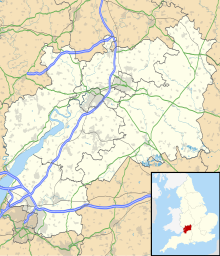Cotswold Commons and Beechwoods
| Site of Special Scientific Interest | |
 Cranham Common | |
| Location | Gloucestershire |
|---|---|
| Grid reference | SO900130 |
| Coordinates | 51°48′58″N 2°08′45″W / 51.815989°N 2.145745°W |
| Interest | Biological |
| Area | 665.5 hectare |
| Notification | 1954 |
| Natural England website | |
Cotswold Commons and Beechwoods (grid reference SO900130) is a 665.5-hectare (1,644-acre) biological Site of Special Scientific Interest in Gloucestershire, notified in 1954.[1][2][3][4]
The Commons and Beechwoods lie within the Cotswold Area of Outstanding Natural Beauty. The site includes the Cotswold Commons and Beechwoods National Nature Reserve[5] and Cooper's Hill Local Nature Reserve. It is part registered as common land and part owned by National Trust.[1]
The Cotswold Beechwoods are recognised as a Special Area of Conservation (SAC) under the EU Habitats Directive.[6][7]
Location
The site comprises ancient Beech woodland and unimproved grassland. It overlies Jurassic limestones and is at the western edge of the Cotswolds. It is located around the villages of Sheepscombe and Cranham, and along the top of the scarp between Painswick and Birdlip.[1]
Species
The woodlands are diverse in their species, and the grasslands are typical of unimproved calcareous pastures well known for the area. The area supports many rare species of plants (including several varieties of orchid) and is an exceptional area for invertebrates. There are some disused limestone mines which are used as winter roosts by several bat species.[1]
Woodland
The beechwoods are currently developed as a high forest structure, but have a long history of management for timber.[1]
Commons
The unimproved limestone grassland is mainly the common lands at Painswick Beacon, Cranham and Sheepscombe.[1]
Publications
References
- ^ a b c d e f Natural England SSSI information on the citation
- ^ Cotswold District Local Plan, Appendix 1, Sites of Special Scientific Interest Archived 26 March 2012 at the Wayback Machine
- ^ Stroud District Local Plan, adopted November 2005, Appendix 6 ‘Sites of Nature Conservation Interest’
- ^ Tewkesbury Borough Local Plan to 2011, adopted March 2006, Appendix 3 'Nature Conservation', Sites of Special Scientific Interest
- ^ Natural England information on the woods of the NNR (maps, publications)
- ^ Information on Cotswold Commons and Beechwoods Special Area of Conservation designation
- ^ Joint Nature Conservation Committee Listing of Special Areas of Conservation
SSSI Source
- Natural England SSSI information on the citation
- Natural England SSSI information on the Cotswold Commons and Beechwoods units
External links
![]() Media related to Buckholt Wood at Wikimedia Commons
Media related to Buckholt Wood at Wikimedia Commons
- Natural England (SSSI information)
- National Trust
-
Workmans Woods, Sheepscombe
-
Track in Workmans Wood
-
Track in Workmans Wood
-
Cranham Wood





